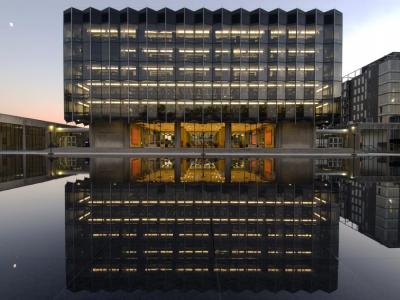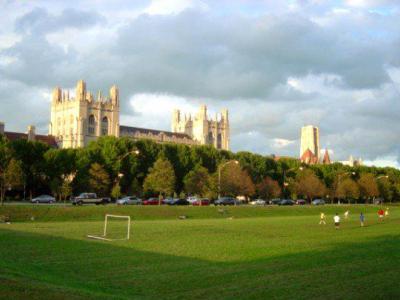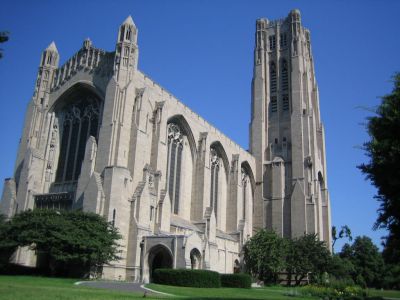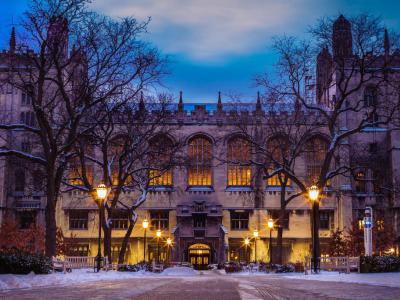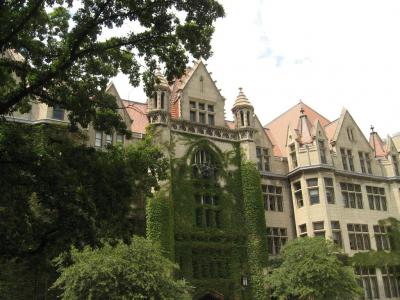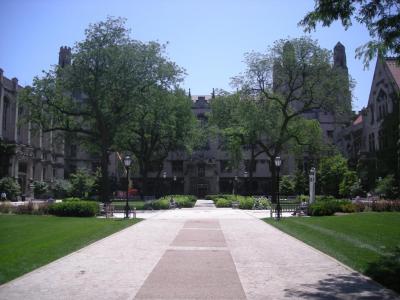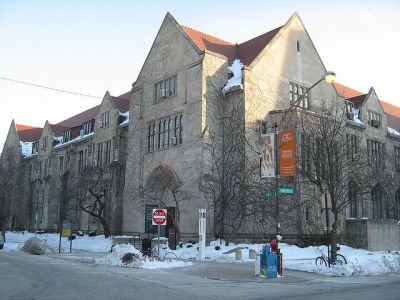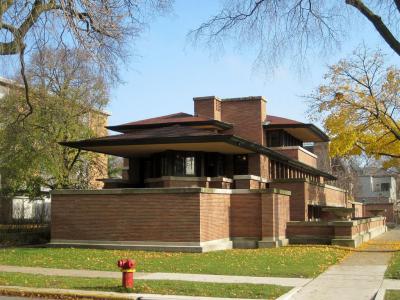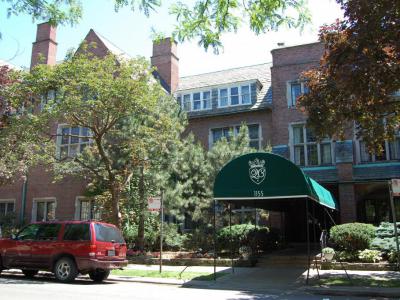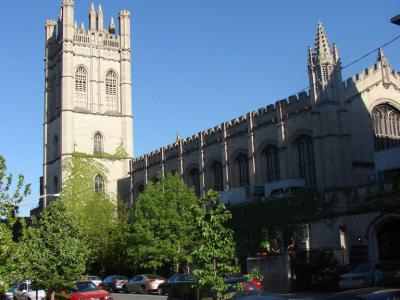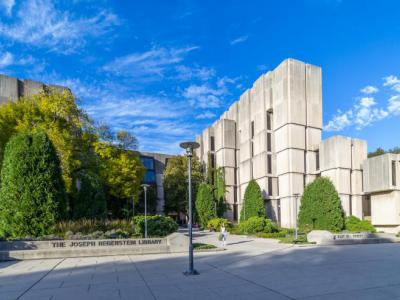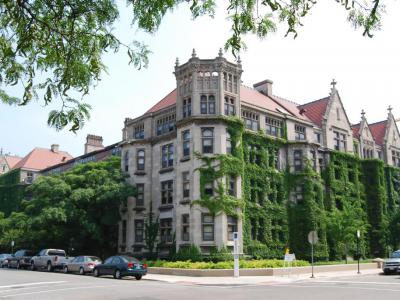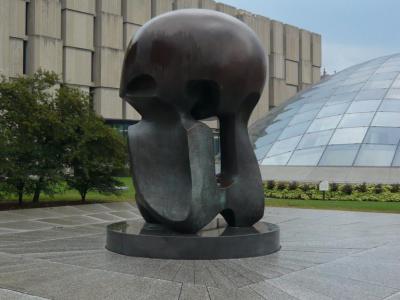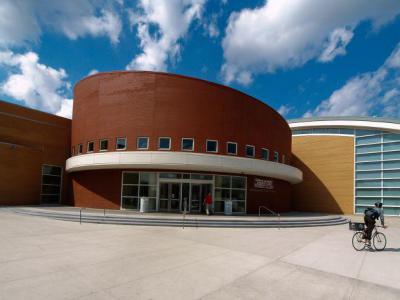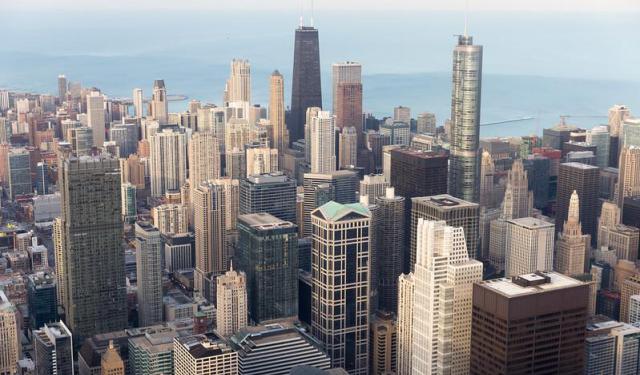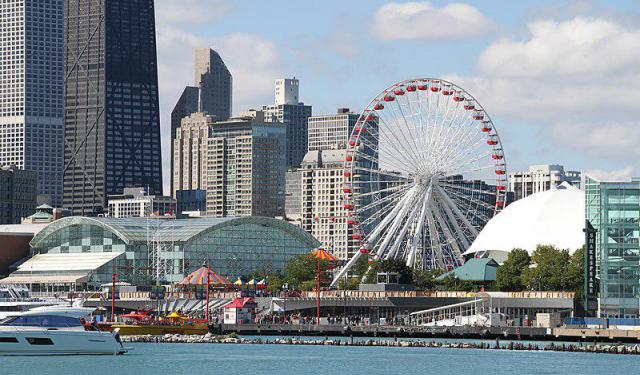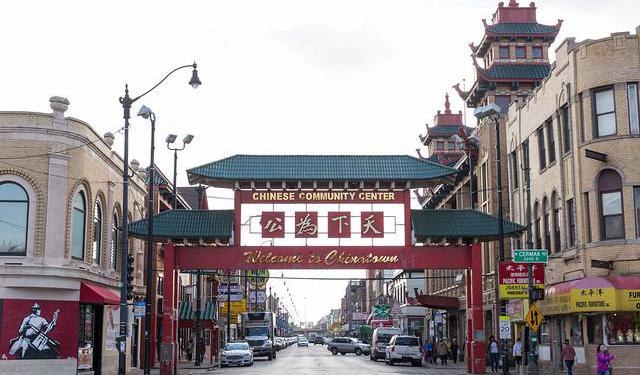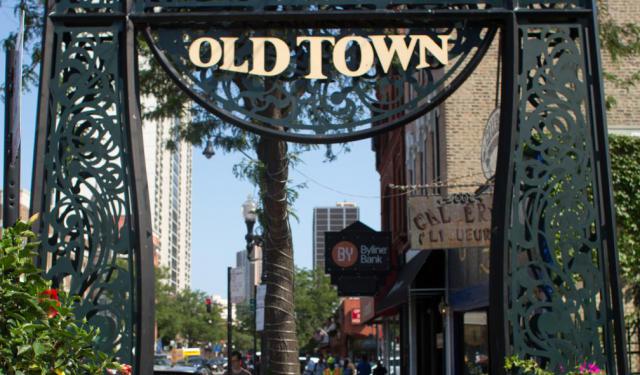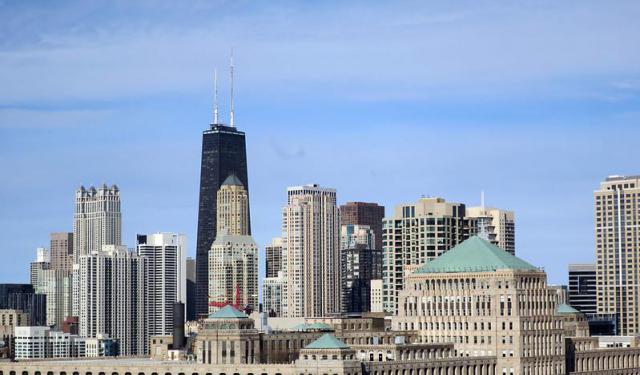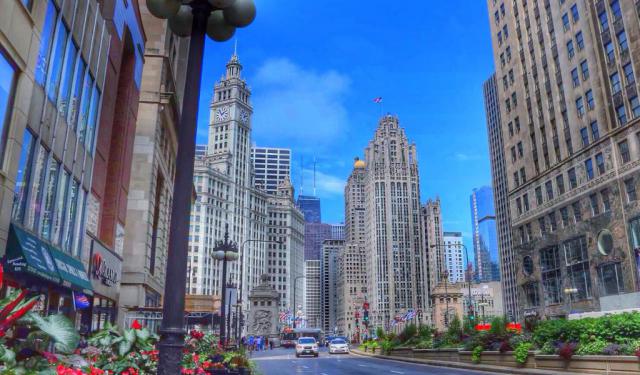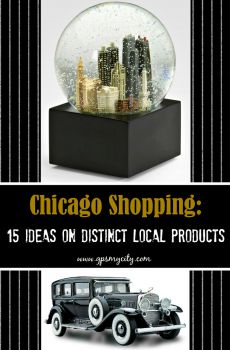University of Chicago Walking Tour (Self Guided), Chicago
Founded in 1890, the University of Chicago is among the world’s most prestigious educational institutions. As of 2020, the University’s students, faculty and staff have included 100 Nobel laureates, giving it the fourth-most affiliated Nobel laureates of any university.
Set in the heart of Chicago’s famous eclectic neighborhood, Hyde Park, the campus is worth a visit as it offers a wonderful chance to walk amongst impressive buildings that range from Academic Gothic forms to Neoclassical to the latest in contemporary design – all making for an interesting experience as you stroll around, bumping shoulders with students and faculty.
While the Midway Plaisance is a favorite destination for biking, walking, sitting and studying in the summer (or skating in the winter), you will want to stop by several landmarks like the Rockefeller Chapel – the University’s official “church”, glorious as ever with its high ceiling and huge organ inside; the Oriental Museum, housing rare (and huge) Near Eastern artifacts; the architecturally significant, painstakingly restored Robie House; the glass-domed Mansueto Library and the Henry Moore sculpture on the site of the first sustained nuclear reaction (next to the Regenstein Library).
Most of these sites (and more!) are free or by suggested donation, so give yourself time to take in everything at your own pace, guided by our self-guided walking tour.
Set in the heart of Chicago’s famous eclectic neighborhood, Hyde Park, the campus is worth a visit as it offers a wonderful chance to walk amongst impressive buildings that range from Academic Gothic forms to Neoclassical to the latest in contemporary design – all making for an interesting experience as you stroll around, bumping shoulders with students and faculty.
While the Midway Plaisance is a favorite destination for biking, walking, sitting and studying in the summer (or skating in the winter), you will want to stop by several landmarks like the Rockefeller Chapel – the University’s official “church”, glorious as ever with its high ceiling and huge organ inside; the Oriental Museum, housing rare (and huge) Near Eastern artifacts; the architecturally significant, painstakingly restored Robie House; the glass-domed Mansueto Library and the Henry Moore sculpture on the site of the first sustained nuclear reaction (next to the Regenstein Library).
Most of these sites (and more!) are free or by suggested donation, so give yourself time to take in everything at your own pace, guided by our self-guided walking tour.
How it works: Download the app "GPSmyCity: Walks in 1K+ Cities" from Apple App Store or Google Play Store to your mobile phone or tablet. The app turns your mobile device into a personal tour guide and its built-in GPS navigation functions guide you from one tour stop to next. The app works offline, so no data plan is needed when traveling abroad.
University of Chicago Walking Tour Map
Guide Name: University of Chicago Walking Tour
Guide Location: USA » Chicago (See other walking tours in Chicago)
Guide Type: Self-guided Walking Tour (Sightseeing)
# of Attractions: 14
Tour Duration: 2 Hour(s)
Travel Distance: 2.5 Km or 1.6 Miles
Author: ashley
Sight(s) Featured in This Guide:
Guide Location: USA » Chicago (See other walking tours in Chicago)
Guide Type: Self-guided Walking Tour (Sightseeing)
# of Attractions: 14
Tour Duration: 2 Hour(s)
Travel Distance: 2.5 Km or 1.6 Miles
Author: ashley
Sight(s) Featured in This Guide:
- Laird Bell Law Quadrangle
- Midway Plaisance
- Rockefeller Memorial Chapel
- Harper Memorial Library
- Cobb Lecture Hall
- Main Quadrangle
- Institute for the Study of Ancient Cultures
- Robie House
- Quadrangle Club
- Tower Group and Hutchinson Commons
- Regenstein Library and Mansueto Library
- Snell–Hitchcock Hall
- Nuclear Energy (sculpture)
- Gerald Ratner Athletics Center
1) Laird Bell Law Quadrangle
Home to the Law School, this complex designed by Finnish-American architect Eero Saarinen stands as his most significant contribution to the University of Chicago campus. In line with the tradition of grouping buildings of similar disciplines around a central court, Saarinen orchestrated the creation of four structures: Constitution Hall, a classroom building, the law library, and the administration building, all encircling a reflective pool and fountain. In November 1960, Saarinen was quoted in 'Architectural Record', expressing the intention to create a harmonious relationship with the Gothic dormitories by emphasizing a small, fragmented scale, a dynamic silhouette, and notably, verticality in the library's design.
Recognized as a pinnacle of modern architecture, this complex aligns with the Modernist emphasis on horizontal lines and interconnected spaces. Saarinen employed the same Indiana limestone used in the Gothic buildings nearby, while the adjacent fountain and landscaping by Dan Kiley added a touch of softness to the Mondrian-like order, maintaining the architectural balance.
In the same vicinity, the bronze sculpture 'Construction in the Third and Fourth Dimension' (1961–62), commissioned for this space, was crafted by Antoine Pevsner, a Russian-born sculptor known for his work in Cubist and Constructivist styles. As early as 1920, Pevsner advocated for art to engage in four dimensions, including time. In this sculpture, Pevsner exploited the distortion of flat metal planes, which theoretically could extend infinitely. The surface's striations also hint at the potential for the infinite.
A comprehensive renovation and modernization project in 2008 restored these structures to their former glory while adapting them to contemporary requirements. The D'Angelo Law Library tower, the standout feature of the complex, and the reflecting pool both received impressive makeovers and earned the 2008 Richard H. Driehaus Foundation Preservation Award for Rehabilitation.
Recognized as a pinnacle of modern architecture, this complex aligns with the Modernist emphasis on horizontal lines and interconnected spaces. Saarinen employed the same Indiana limestone used in the Gothic buildings nearby, while the adjacent fountain and landscaping by Dan Kiley added a touch of softness to the Mondrian-like order, maintaining the architectural balance.
In the same vicinity, the bronze sculpture 'Construction in the Third and Fourth Dimension' (1961–62), commissioned for this space, was crafted by Antoine Pevsner, a Russian-born sculptor known for his work in Cubist and Constructivist styles. As early as 1920, Pevsner advocated for art to engage in four dimensions, including time. In this sculpture, Pevsner exploited the distortion of flat metal planes, which theoretically could extend infinitely. The surface's striations also hint at the potential for the infinite.
A comprehensive renovation and modernization project in 2008 restored these structures to their former glory while adapting them to contemporary requirements. The D'Angelo Law Library tower, the standout feature of the complex, and the reflecting pool both received impressive makeovers and earned the 2008 Richard H. Driehaus Foundation Preservation Award for Rehabilitation.
2) Midway Plaisance
For an impressive introduction to the University of Chicago, take a stroll along the Midway Plaisance, a lengthy verdant stretch that once served as the location for the 1893 World's Columbian Exposition. During that time, the Midway was transformed into a bustling showcase of life-sized model villages from various corners of the world, including an Irish market town and a replica of Cairo complete with belly dancers. Today, it primarily serves as a thoroughfare for joggers and a recreational spot for students enjoying games of Frisbee.
Despite its name blending contrasting elements of the mundane and the refined, the Midway Plaisance is, in fact, a spacious boulevard with a vast sunken grassy median that traverses the southern portion of the University campus, providing a striking view of the historic buildings on the way. Its entire length of the Midway is flanked by trees and adorned with landscaping that enhances its overall appeal.
Designed by Frederick Law Olmsted, the boulevard is situated adjacent to several vital components of the University of Chicago campus: the Graham School of Liberal and Professional Studies, the Harris School of Public Policy, the School of Social Service Administration, and the University of Chicago Law School.
In the 21st century, developments on the Midway have introduced an ice rink and a warming house (in 2002), while the Midway Crossings (2010–13) at Ellis, Woodlawn, and Dorchester Avenues stand as towering light installations, visually connecting the campus' northern and southern sections. Additionally, you can discover an older statue honoring botanist and zoologist Carl Linnaeus, as well as a statue depicting the Blanik Mountain Knight – a monumental symbol of eternally valid ideals: freedom, democracy and humanity.
Despite its name blending contrasting elements of the mundane and the refined, the Midway Plaisance is, in fact, a spacious boulevard with a vast sunken grassy median that traverses the southern portion of the University campus, providing a striking view of the historic buildings on the way. Its entire length of the Midway is flanked by trees and adorned with landscaping that enhances its overall appeal.
Designed by Frederick Law Olmsted, the boulevard is situated adjacent to several vital components of the University of Chicago campus: the Graham School of Liberal and Professional Studies, the Harris School of Public Policy, the School of Social Service Administration, and the University of Chicago Law School.
In the 21st century, developments on the Midway have introduced an ice rink and a warming house (in 2002), while the Midway Crossings (2010–13) at Ellis, Woodlawn, and Dorchester Avenues stand as towering light installations, visually connecting the campus' northern and southern sections. Additionally, you can discover an older statue honoring botanist and zoologist Carl Linnaeus, as well as a statue depicting the Blanik Mountain Knight – a monumental symbol of eternally valid ideals: freedom, democracy and humanity.
3) Rockefeller Memorial Chapel
Standing tall above the Midway Plaisance, this massive limestone church crafted from loadbearing masonry limestone employs classical Gothic architectural elements such as arches and buttresses. Bertram Grosvenor Goodhue, a nationally renowned advocate of the Gothic Revival and Arts and Crafts movements, envisioned this design as his interpretation of Modern Gothic.
The university administration played a significant role in the design process, with President Ernest DeWitt Burton even embarking on tours of famous English cathedrals to ensure the design's appropriateness. The most noticeable departure from medieval Gothic lies in the proportions, characterized by unusually wide bays and tall clerestory windows above low side aisles, as well as an abundance of smooth, flat surfaces. A central feature of the chapel is its tower, accessible via a climb of 271 steps, offering impressive views and housing a carillon frequently used for concerts. Within the main building, Bond Chapel is a popular venue for artistic and musical events.
The interior has a serene and calming color palette, along with a unique example of Guastavino tile vaulting, where the tiles serve a structural rather than purely decorative purpose. The sculptural elements encompass religious figures, allegorical representations, historical figures, coats of arms, and inscriptions. A statue of Goodhue on the east transept wall symbolizes architecture, with Rockefeller Chapel in his hands and West Point Chapel in the background. Opposite him stands Bach, representing music. Choral performances are a beloved tradition at the chapel, often featuring music associated with the traditional Church seasons.
The university administration played a significant role in the design process, with President Ernest DeWitt Burton even embarking on tours of famous English cathedrals to ensure the design's appropriateness. The most noticeable departure from medieval Gothic lies in the proportions, characterized by unusually wide bays and tall clerestory windows above low side aisles, as well as an abundance of smooth, flat surfaces. A central feature of the chapel is its tower, accessible via a climb of 271 steps, offering impressive views and housing a carillon frequently used for concerts. Within the main building, Bond Chapel is a popular venue for artistic and musical events.
The interior has a serene and calming color palette, along with a unique example of Guastavino tile vaulting, where the tiles serve a structural rather than purely decorative purpose. The sculptural elements encompass religious figures, allegorical representations, historical figures, coats of arms, and inscriptions. A statue of Goodhue on the east transept wall symbolizes architecture, with Rockefeller Chapel in his hands and West Point Chapel in the background. Opposite him stands Bach, representing music. Choral performances are a beloved tradition at the chapel, often featuring music associated with the traditional Church seasons.
4) Harper Memorial Library
Dominating the skyline with its twin imposing towers, this library, established in 1912, showcases remarkable Gothic architectural elements, drawing inspiration from renowned Oxford institutions like Christ Church College and Magdalen College, as well as King's College in Cambridge. Notably, its expansive size allows for the inclusion of research centers alongside its regular collections, encompassing resources dedicated to East and South Asian materials, as well as an extensive map collection, all open for visitors to explore. Beyond books and related printed materials, the library also houses an art collection featuring diverse exhibits, spanning subjects such as the University's history, Black history and culture, the ideological contrasts between North and South Korea, and more.
This edifice played a pivotal role as the initial significant component in the southern cluster of buildings facing the Midway. Its placement was a result of a comprehensive campus plan devised in 1902, which aimed to centralize the humanities and social sciences buildings in the southern part of the quadrangles, transitioning them from residential to academic use. As subsequent buildings within the plan were finished (the last one in 1929), second-story bridges were added to link the library to reading rooms and department libraries.
Visitors can venture into the third-floor reading room, a grand space distinguished by a row of arched, double-height windows on its exterior. Look for the university's coat of arms, designed during this period to be included in the room's overall iconography alongside emblems of other esteemed institutions. Crossing the bridge leads to another reading room within Stuart Hall, which has been modernized but retains an intricate ceiling.
This edifice played a pivotal role as the initial significant component in the southern cluster of buildings facing the Midway. Its placement was a result of a comprehensive campus plan devised in 1902, which aimed to centralize the humanities and social sciences buildings in the southern part of the quadrangles, transitioning them from residential to academic use. As subsequent buildings within the plan were finished (the last one in 1929), second-story bridges were added to link the library to reading rooms and department libraries.
Visitors can venture into the third-floor reading room, a grand space distinguished by a row of arched, double-height windows on its exterior. Look for the university's coat of arms, designed during this period to be included in the room's overall iconography alongside emblems of other esteemed institutions. Crossing the bridge leads to another reading room within Stuart Hall, which has been modernized but retains an intricate ceiling.
5) Cobb Lecture Hall
This structure represents the University's initial construction, one of eighteen conceived by architect Cobb during his tenure from 1891 to 1901 as the campus architect. Named after donor Silas B. Cobb (unrelated to the architect), it marked the beginning of the Gothic architectural style that would be adhered to for the next four decades; however, it possesses a robust character that alludes to the architect's inclination towards the Romanesque style, as evidenced by the red tile roofs.
In fact, Cobb needed some persuasion to embrace the Gothic style instead of the Romanesque style he had used in designing the Newberry Library. The trustees were adamant that the ecclesiastical and educational connotations of the Gothic style made it a more fitting choice for a university compared to the Romanesque, which was popular for commercial structures at the time. Despite his initial reluctance, Cobb executed an expert interpretation of the Gothic style, characterized by gables and dormers puncturing steeply pitched roofs, crowned with vigorous crockets. Oriel windows, bays, and pavilion-like projections break the monotony of the wall surfaces, creating a distinctly medieval impression of picturesque irregularity while maintaining the buildings' essential symmetry.
The lecture hall has been actively used since 1892, providing not only classrooms and offices but also a chapel and recitation hall. Visitors exploring the interior will observe Chicago School influences, primarily driven by utilitarian considerations. On the 4th floor, the Bergman Gallery hosts exhibitions of significant modern art by the Renaissance Society, a tradition spanning many decades. While visiting the lecture hall, one can also explore the Center for the Study of Languages, an excellent resource for delving into the evolution of language.
In fact, Cobb needed some persuasion to embrace the Gothic style instead of the Romanesque style he had used in designing the Newberry Library. The trustees were adamant that the ecclesiastical and educational connotations of the Gothic style made it a more fitting choice for a university compared to the Romanesque, which was popular for commercial structures at the time. Despite his initial reluctance, Cobb executed an expert interpretation of the Gothic style, characterized by gables and dormers puncturing steeply pitched roofs, crowned with vigorous crockets. Oriel windows, bays, and pavilion-like projections break the monotony of the wall surfaces, creating a distinctly medieval impression of picturesque irregularity while maintaining the buildings' essential symmetry.
The lecture hall has been actively used since 1892, providing not only classrooms and offices but also a chapel and recitation hall. Visitors exploring the interior will observe Chicago School influences, primarily driven by utilitarian considerations. On the 4th floor, the Bergman Gallery hosts exhibitions of significant modern art by the Renaissance Society, a tradition spanning many decades. While visiting the lecture hall, one can also explore the Center for the Study of Languages, an excellent resource for delving into the evolution of language.
6) Main Quadrangle
At the core of the University of Chicago lies the Main Quadrangle, also known as "The Quads". This area is enveloped by neo-Gothic offices and libraries (including the octagonally designed Kent Chemical Laboratory and Ryerson Hall, which features an observatory) and serves as the campus's bustling hub, typically teeming with students coming and going from their classes. Envisioned by Henry Ives Cobb, visitors and students alike can take advantage of the 215 acres of lush green space.
In 1997, the American Public Garden Association granted the quadrangle the status of a Botanic Garden. Within this space, a dozen modest-sized gardens contribute to the lush greenery, with generous donors ensuring their continual upkeep. Among these, the Dan Hall Garden stands out as a particularly popular spot, offering a serene setting for reflection and relaxation. Meanwhile, in the southeast corner, the tranquil Social Science Quad provides an ideal location to contemplate the periodic chiming of the bells.
These landscaped areas provide a striking contrast to the Gothic-style buildings and offer captivating sights throughout the year. Spring and summer bring vibrant blooms of flowers, trees, and shrubs, while the fall season graces the quadrangle with rich and vivid hues. Even in the winter, when covered in a blanket of snow, the quadrangle maintains its impressive appeal.
In 1997, the American Public Garden Association granted the quadrangle the status of a Botanic Garden. Within this space, a dozen modest-sized gardens contribute to the lush greenery, with generous donors ensuring their continual upkeep. Among these, the Dan Hall Garden stands out as a particularly popular spot, offering a serene setting for reflection and relaxation. Meanwhile, in the southeast corner, the tranquil Social Science Quad provides an ideal location to contemplate the periodic chiming of the bells.
These landscaped areas provide a striking contrast to the Gothic-style buildings and offer captivating sights throughout the year. Spring and summer bring vibrant blooms of flowers, trees, and shrubs, while the fall season graces the quadrangle with rich and vivid hues. Even in the winter, when covered in a blanket of snow, the quadrangle maintains its impressive appeal.
7) Institute for the Study of Ancient Cultures
Designed with an Art Deco aesthetic that balances the Gothic architectural elements of gables, bays, and buttresses, this building's origins trace back to the early 20th century when University of Chicago archaeologists collected artifacts (one of whom is rumored to have inspired Indiana Jones). Over time, it has evolved into an interesting and informative museum showcasing an astounding array of relics from the ancient Middle East, particularly Egypt, Mesopotamia, Iran, and Anatolia. Boasting the largest collection of such antiquities in the United States, the exhibits feature a diverse array of items, including amulets, mummies, limestone reliefs, gold jewelry, ivories, pottery, and bronzes spanning from the 8th millennium BC to the 13th century AD.
Among the most remarkable discoveries is a collection of bronze figurines unearthed in southeast Turkey, dated 3000 BC and considered the world's earliest bronze artifacts. Notable exhibits also include a fragment of the Dead Sea Scrolls, one of the few ancient Hebrew manuscript fragments on display in the US, and a presentation of findings from the institute's excavation at Megiddo (biblically known as Armageddon and considered the birthplace of Israeli archaeology). Don't miss the exquisitely carved Megiddo ivories from 1300 BC.
The Egyptian Gallery's standout piece is the "Colossal Statue of King Tutankhamun", dating from 1334 BC (though not truly colossal, it stands impressively tall at 17 feet). Many artifacts in the Persian Room were excavated by the Oriental Institute during the 1930s, a time when the University of Chicago was at the pinnacle of archaeological exploration. Notable pieces include the robust "Colossal Bull Head" from Iran, one of a pair of beautifully carved stone statues dating from 486 to 424 BC. Additionally, there's a lavish collection of Achaemenid art uncovered during excavations at Persepolis, the ceremonial capital of the Persian Empire from 612 to 330 BC, in the 1930s.
Among the most remarkable discoveries is a collection of bronze figurines unearthed in southeast Turkey, dated 3000 BC and considered the world's earliest bronze artifacts. Notable exhibits also include a fragment of the Dead Sea Scrolls, one of the few ancient Hebrew manuscript fragments on display in the US, and a presentation of findings from the institute's excavation at Megiddo (biblically known as Armageddon and considered the birthplace of Israeli archaeology). Don't miss the exquisitely carved Megiddo ivories from 1300 BC.
The Egyptian Gallery's standout piece is the "Colossal Statue of King Tutankhamun", dating from 1334 BC (though not truly colossal, it stands impressively tall at 17 feet). Many artifacts in the Persian Room were excavated by the Oriental Institute during the 1930s, a time when the University of Chicago was at the pinnacle of archaeological exploration. Notable pieces include the robust "Colossal Bull Head" from Iran, one of a pair of beautifully carved stone statues dating from 486 to 424 BC. Additionally, there's a lavish collection of Achaemenid art uncovered during excavations at Persepolis, the ceremonial capital of the Persian Empire from 612 to 330 BC, in the 1930s.
8) Robie House
Designed in 1908 by Frank Lloyd Wright for a bicycle and motorcycle manufacturer, this house ranks among the world's most renowned structures. Remarkably poised, resembling a grand steamship at anchor, it embodies the distilled essence of Wright's Prairie style and marks the pinnacle of his quest for a new architectural vision. Additionally, it is among the final Prairie houses Wright created, as during its construction, he abandoned both his Oak Park practice and his family to embark on a new phase of his illustrious career.
Taking inspiration from the flat expanses of the Midwestern prairie and aiming to establish a distinctly American architectural style, Wright conceived a predominantly horizontal dwelling for Frederick Robie. The cantilevered roof appears to hover gracefully over the building, extending an impressive 20 feet from its supports. The primary floor unfolds as a fluid, open space devoid of walls or partitions, with the fireplace serving as a visual divider between the living and dining areas.
In his pursuit of aesthetic consistency, Wright was willing to sacrifice practicality, evident in his decision to exclude downspouts from the building's drainage system, resulting in nearly a century of water damage to the pavements. Wright's commitment to unification extended to every aspect of the project – he meticulously designed everything, from the structure itself to the landscaping, light fixtures, chairs, and even the attire for the Robies' two children. His unexpected visits to ensure that all elements remained in their intended positions became known, and the Robies devised a strategy to rearrange the rooms before inviting him in.
Following the Robie family's financial downfall, the house changed hands several times in quick succession. In 1926, it was acquired by the Chicago Theological Seminary, which transformed it into student housing, causing significant damage in the process. By 1957, the Seminary had amassed enough funds to pursue its original plan of demolishing the structure entirely. It took the philanthropic intervention of businessman William Zeckendorff to rescue the house, which he subsequently donated to the University of Chicago in 1963. Now recognized as a National Historic Landmark and a UNESCO World Heritage Site, this Hyde Park residence underwent a $2.9 million restoration in 2019. Guided tours are available from Thursday through Monday.
Taking inspiration from the flat expanses of the Midwestern prairie and aiming to establish a distinctly American architectural style, Wright conceived a predominantly horizontal dwelling for Frederick Robie. The cantilevered roof appears to hover gracefully over the building, extending an impressive 20 feet from its supports. The primary floor unfolds as a fluid, open space devoid of walls or partitions, with the fireplace serving as a visual divider between the living and dining areas.
In his pursuit of aesthetic consistency, Wright was willing to sacrifice practicality, evident in his decision to exclude downspouts from the building's drainage system, resulting in nearly a century of water damage to the pavements. Wright's commitment to unification extended to every aspect of the project – he meticulously designed everything, from the structure itself to the landscaping, light fixtures, chairs, and even the attire for the Robies' two children. His unexpected visits to ensure that all elements remained in their intended positions became known, and the Robies devised a strategy to rearrange the rooms before inviting him in.
Following the Robie family's financial downfall, the house changed hands several times in quick succession. In 1926, it was acquired by the Chicago Theological Seminary, which transformed it into student housing, causing significant damage in the process. By 1957, the Seminary had amassed enough funds to pursue its original plan of demolishing the structure entirely. It took the philanthropic intervention of businessman William Zeckendorff to rescue the house, which he subsequently donated to the University of Chicago in 1963. Now recognized as a National Historic Landmark and a UNESCO World Heritage Site, this Hyde Park residence underwent a $2.9 million restoration in 2019. Guided tours are available from Thursday through Monday.
9) Quadrangle Club
Established in 1893, the Quadrangle Club originally served as a social venue for the faculty of the newly founded University of Chicago. Its primary purpose was to serve as a space for "study, socialization, and especially communication", and from its inception, it welcomed not only faculty but also members of the broader community. As the University expanded, so did the club's membership, leading to the construction of a new building in 1922, designed by Howard Van Doren Shaw. This new structure featured red brick and a multi-colored slate roof, deliberately chosen to harmonize with the grey stone aesthetics of other University buildings. The club expanded its facilities to accommodate larger gatherings and introduced a tennis program at its new location.
Throughout the 20th century, the Quadrangle Club hosted a diverse range of cultural and community events for its members. These included "First Friday" Jazz Nights, banquets, lectures, musical performances, and the annual "Revels", which originated in 1904 as a Christmas pageant and, by the 1950s, had transformed into a full-scale song-and-dance revue satirizing University life.
What truly sets the club apart is its history of hosting some of the most groundbreaking ideas in human history. Distinguished figures such as Albert Michelson, the first American Nobel laureate in science, and Leo Szilard, a collaborator with Enrico Fermi on the Manhattan Project, have stayed here. Esteemed faculty members, including Nobel Prize winners like astrophysicist Subrahmanyan Chandrasekhar and economist Milton Friedman, were regular visitors during their tenure at the University.
Today, the club remains an essential hub for intellectual and social activities at the University of Chicago, providing a convenient meeting place for faculty, visitors, and the community, and hosting various important University events, both formal and informal.
Throughout the 20th century, the Quadrangle Club hosted a diverse range of cultural and community events for its members. These included "First Friday" Jazz Nights, banquets, lectures, musical performances, and the annual "Revels", which originated in 1904 as a Christmas pageant and, by the 1950s, had transformed into a full-scale song-and-dance revue satirizing University life.
What truly sets the club apart is its history of hosting some of the most groundbreaking ideas in human history. Distinguished figures such as Albert Michelson, the first American Nobel laureate in science, and Leo Szilard, a collaborator with Enrico Fermi on the Manhattan Project, have stayed here. Esteemed faculty members, including Nobel Prize winners like astrophysicist Subrahmanyan Chandrasekhar and economist Milton Friedman, were regular visitors during their tenure at the University.
Today, the club remains an essential hub for intellectual and social activities at the University of Chicago, providing a convenient meeting place for faculty, visitors, and the community, and hosting various important University events, both formal and informal.
10) Tower Group and Hutchinson Commons
In 1903, Shepley, Rutan & Coolidge made a notable debut on the campus with a grand cluster of buildings anchoring the northeast corner of the Main Quadrangle. This architectural endeavor marked a growing emphasis on historicism, striving to align the interior spaces with the style of the exteriors, all of which exude a spacious and distinctly Old World ambiance.
In an early effort to establish a connection between their emerging institution and prestigious historic European universities, particularly those in England, benefactor Charles L. Hutchinson and architect Charles A. Coolidge embarked on a journey to Oxford to study its rich collegiate architectural heritage. The design of Mitchell Tower, the campus's first purely ornamental building, drew inspiration from the bell tower of Magdalen College. The ten Palmer chimes, named in honor of Alice Freeman Palmer, the first dean of women, continue to be employed for change ringing, a traditional English style of bell-ringing that some may find dissonant.
Initially serving as a men's dining hall, Hutchinson Commons took its cues from Oxford's Christ Church Hall. Visitors can relish an affordably priced meal in the grand dining room, notable for its impressive hammer-beam ceiling and an array of portraits depicting trustees and benefactors, including figures such as John D. Rockefeller and Martin Ryerson. The adjacent courtyard offers an inviting spot to explore.
Reynolds Club, the University's central student hub, draws inspiration from the 15th-century Saint John's College at Oxford, cultivating a homey atmosphere underscored by a staircase hall reminiscent of an English manor house.
In an early effort to establish a connection between their emerging institution and prestigious historic European universities, particularly those in England, benefactor Charles L. Hutchinson and architect Charles A. Coolidge embarked on a journey to Oxford to study its rich collegiate architectural heritage. The design of Mitchell Tower, the campus's first purely ornamental building, drew inspiration from the bell tower of Magdalen College. The ten Palmer chimes, named in honor of Alice Freeman Palmer, the first dean of women, continue to be employed for change ringing, a traditional English style of bell-ringing that some may find dissonant.
Initially serving as a men's dining hall, Hutchinson Commons took its cues from Oxford's Christ Church Hall. Visitors can relish an affordably priced meal in the grand dining room, notable for its impressive hammer-beam ceiling and an array of portraits depicting trustees and benefactors, including figures such as John D. Rockefeller and Martin Ryerson. The adjacent courtyard offers an inviting spot to explore.
Reynolds Club, the University's central student hub, draws inspiration from the 15th-century Saint John's College at Oxford, cultivating a homey atmosphere underscored by a staircase hall reminiscent of an English manor house.
11) Regenstein Library and Mansueto Library
Architect Walter A. Netsch Jr. introduced the concept of concrete brutalism to the traditional University of Chicago campus, resulting in the Regenstein Library, which made a bold departure from the norm. The building's irregular massing, slit windows, and vertically grooved facade ostensibly drew inspiration from the surrounding Gothic buildings but primarily reflected Netsch's distinctive design vision. Constructed with grooved limestone, which, from a distance, resembles concrete, the building is often noted by university tour guides for its resemblance to the fore edge of a book. In reality, it stands as one of the world's largest book repositories, highly regarded by its users. In addition, it serves as a popular gathering place for the University's students and houses the Special Collections Research Center, home to rare book collections, manuscripts, and university archives.
In stark contrast, Mansueto Library, designed by German-American architect Helmut Jahn, exhibits significant differences from Regenstein, featuring a transparent, self-supporting dome consisting of 691 rhombus-shaped glass panels, seemingly hovering above a well-lit reading room. Below ground, the library houses five floors of storage space accommodating around 3.5 million volumes, all easily accessible via an impressive robotic retrieval system. Mr. Jahn often characterizes his architectural approach as "archineering", reflecting the innovative engineering that underpins his projects, yet the overarching objective is "elegant minimalism", a goal that the Mansueto Library impeccably achieves, earning it several architectural accolades in the years following its dedication.
In stark contrast, Mansueto Library, designed by German-American architect Helmut Jahn, exhibits significant differences from Regenstein, featuring a transparent, self-supporting dome consisting of 691 rhombus-shaped glass panels, seemingly hovering above a well-lit reading room. Below ground, the library houses five floors of storage space accommodating around 3.5 million volumes, all easily accessible via an impressive robotic retrieval system. Mr. Jahn often characterizes his architectural approach as "archineering", reflecting the innovative engineering that underpins his projects, yet the overarching objective is "elegant minimalism", a goal that the Mansueto Library impeccably achieves, earning it several architectural accolades in the years following its dedication.
12) Snell–Hitchcock Hall
Amos J. Snell Hall and Charles Hitchcock Hall, commonly referred to as Snell–Hitchcock, comprise a residential complex at the University of Chicago. Erected in 1892 and 1901, respectively, they hold the distinction of being the oldest residential halls still in active use on the university's campus. Collectively, they represent a unique interpretation of the Gothic architectural style predating World War II. Designed by Dwight H. Perkins, the buildings incorporate principles of the Prairie School, evident in the low-pitched roof, dormers, and overall horizontal emphasis. The ornamentation also deviated from convention, featuring geometric stained-glass windows and depictions of prairie vegetation, such as corncobs, as substitutes for the abstracted English flora commonly associated with Gothic design. Perkins, a family friend of donor Mrs. Charles Hitchcock, was among the few external architects commissioned to design a campus building.
The Snell building is notably half the size of Hitchcock, accommodating around 50 residents across four floors. It has the distinction of initially being one of the first women's dormitories on a coeducational campus; however, this arrangement was short-lived, as once the dedicated women's dormitory became available, Snell transitioned to housing men. All rooms within Snell are singles, with the exception of a two-room suite on the second floor. While three of the four floors accommodate residents of both genders, the third floor is exclusively for women. In the basement, there are amenities such as a co-op kitchen, a laundry room, and a small recreational area, which connects with Hitchcock Hall. The central lounge, known as the Tea Room, features oak paneling, a non-operational fireplace, a wide selection of periodicals, and a well-thumbed copy of John Rechy's novel "The Sexual Outlaw".
The Snell building is notably half the size of Hitchcock, accommodating around 50 residents across four floors. It has the distinction of initially being one of the first women's dormitories on a coeducational campus; however, this arrangement was short-lived, as once the dedicated women's dormitory became available, Snell transitioned to housing men. All rooms within Snell are singles, with the exception of a two-room suite on the second floor. While three of the four floors accommodate residents of both genders, the third floor is exclusively for women. In the basement, there are amenities such as a co-op kitchen, a laundry room, and a small recreational area, which connects with Hitchcock Hall. The central lounge, known as the Tea Room, features oak paneling, a non-operational fireplace, a wide selection of periodicals, and a well-thumbed copy of John Rechy's novel "The Sexual Outlaw".
13) Nuclear Energy (sculpture)
Crafted to symbolize both a human skull and a mushroom cloud, this abstract bronze structure serves as a commemoration of the pivotal moment that occurred on December 2, 1942. It was at this juncture that Enrico Fermi and his fellow scientists achieved achieved the first controlled, self-sustaining nuclear chain reaction-an event of immense significance in demonstrating the feasibility of creating an atomic bomb. This historic step into the atomic age unfolded within the confines of a squash court situated beneath the bleachers of the now-demolished Stagg Field, which occupied the location where the Regenstein Library stands today.
The selection of Chicago as the project's headquarters was strategic, owing to the city's preexisting pool of accomplished physicists and chemists, its central geographic location far from the coasts, and the availability of ample space and housing. Under the veil of top secrecy, the location was codenamed "the Metallurgical Laboratory" within the broader "Manhattan Project" scientific mission.
Dubbed "Chicago Pile-1", the pioneering nuclear reactor marked the commencement of the Atomic Age; however, after the experiment, it was disassembled and relocated to a more secluded site within a forest preserve outside Chicago. The original location was subsequently designated as a National Historic Landmark on February 18, 1965.
The selection of Chicago as the project's headquarters was strategic, owing to the city's preexisting pool of accomplished physicists and chemists, its central geographic location far from the coasts, and the availability of ample space and housing. Under the veil of top secrecy, the location was codenamed "the Metallurgical Laboratory" within the broader "Manhattan Project" scientific mission.
Dubbed "Chicago Pile-1", the pioneering nuclear reactor marked the commencement of the Atomic Age; however, after the experiment, it was disassembled and relocated to a more secluded site within a forest preserve outside Chicago. The original location was subsequently designated as a National Historic Landmark on February 18, 1965.
14) Gerald Ratner Athletics Center
The architecture of this facility breaks up the volumes and sets one wing back to create a plaza that leads to a welcoming rotunda. Inside the lobby, you can spot the very first Heisman Trophy, awarded in 1935 to Jay Berwanger, a University of Chicago halfback. The design of the natatorium and gymnasium buildings incorporates mast-and-cable roof supports, drawing inspiration from the flying buttresses of the Gothic architecture seen throughout the university's campus. In a nutshell, this is the Gerald Ratner Athletics Center, a $51 million sports facility situated within the University of Chicago campus in the Hyde Park neighborhood on Chicago's South Side.
Since its inauguration in 2003, the expansive 150,000-square-foot structure has garnered numerous accolades. In its first year of operation alone, organizations such as the American Council of Engineering Companies, the American Institute of Steel Construction, and the Consulting Engineers Council of Illinois all lauded its excellence in engineering and design. One of the most striking features is the suspended roof, which hangs suspended by cables connected to five towering masts that reach an impressive 100 feet above the ground.
Moreover, the center is renowned for its world-class facilities: it features the 50-meter x 25-yard Myers-McLoraine Swimming Pool, the Bernard DelGiorno Fitness Center, a multipurpose dance studio, competition and auxiliary gymnasia, classroom and meeting room space, and permanent day lockers. Besides serving the university and medical center communities, the facility is open to staff, alumni, retirees, students, and local residents. Ratner also serves as practice space for the UChicago basketball, volleyball, and wrestling teams, complete with a 1,658-seat competition gymnasium for showcasing them.
Unfortunately, access is restricted, but you can admire this impressive structure from a distance.
Since its inauguration in 2003, the expansive 150,000-square-foot structure has garnered numerous accolades. In its first year of operation alone, organizations such as the American Council of Engineering Companies, the American Institute of Steel Construction, and the Consulting Engineers Council of Illinois all lauded its excellence in engineering and design. One of the most striking features is the suspended roof, which hangs suspended by cables connected to five towering masts that reach an impressive 100 feet above the ground.
Moreover, the center is renowned for its world-class facilities: it features the 50-meter x 25-yard Myers-McLoraine Swimming Pool, the Bernard DelGiorno Fitness Center, a multipurpose dance studio, competition and auxiliary gymnasia, classroom and meeting room space, and permanent day lockers. Besides serving the university and medical center communities, the facility is open to staff, alumni, retirees, students, and local residents. Ratner also serves as practice space for the UChicago basketball, volleyball, and wrestling teams, complete with a 1,658-seat competition gymnasium for showcasing them.
Unfortunately, access is restricted, but you can admire this impressive structure from a distance.
Walking Tours in Chicago, Illinois
Create Your Own Walk in Chicago
Creating your own self-guided walk in Chicago is easy and fun. Choose the city attractions that you want to see and a walk route map will be created just for you. You can even set your hotel as the start point of the walk.
Loop District Architecture Walking Tour
The Chicago Loop District-essentially the city’s historic downtown-has long been a stage for architectural innovation and an open-air museum of American architecture.
The construction boom started after the Great Chicago Fire of 1871, which destroyed much of the central business district, gave architects a blank canvas to rebuild the city from the ground up. What followed was a surge of... view more
Tour Duration: 3 Hour(s)
Travel Distance: 4.7 Km or 2.9 Miles
The construction boom started after the Great Chicago Fire of 1871, which destroyed much of the central business district, gave architects a blank canvas to rebuild the city from the ground up. What followed was a surge of... view more
Tour Duration: 3 Hour(s)
Travel Distance: 4.7 Km or 2.9 Miles
Chicago Navy Pier Walking Tour
Additional to scenic views of the lake, the boats, and the city skyline, the Navy Pier offers a variety of attractions on the waterfront – for kids as well as adults – that draw nearly ten million people annually, making this Chicago's most visited spot. Yes, some may see it as a “tourist trap”, but it is worth the time and money to spend some time here, so take this self-guided walk... view more
Tour Duration: 1 Hour(s)
Travel Distance: 1.0 Km or 0.6 Miles
Tour Duration: 1 Hour(s)
Travel Distance: 1.0 Km or 0.6 Miles
Chicago Chinatown Walking Tour
Tucked away just south of the Loop, the Chinatown of Chicago was established in 1912 and is considered one of the best examples of American Chinatown. While it may be one of Chicago’s smallest neighborhoods geographically, it is big on character, colors, sights, sounds, and flavors. Here, you’ll find a wide range of unique boutiques, specialty shops, religious sights, authentic Chinese... view more
Tour Duration: 1 Hour(s)
Travel Distance: 1.7 Km or 1.1 Miles
Tour Duration: 1 Hour(s)
Travel Distance: 1.7 Km or 1.1 Miles
Chicago Old Town Walking Tour
Settled in 1850 by German immigrants, Chicago’s Old Town neighborhood is a popular destination for locals and visitors who cater to the entertainment venues, restaurants, pubs, coffee shops and boutiques – all of which have turned an area once referred to as the “Cabbage Patch” into an attraction that rivals Navy Pier, Wrigley Field and the Magnificent Mile.
Start your Old Town walking... view more
Tour Duration: 2 Hour(s)
Travel Distance: 2.6 Km or 1.6 Miles
Start your Old Town walking... view more
Tour Duration: 2 Hour(s)
Travel Distance: 2.6 Km or 1.6 Miles
Chicago Introduction Walking Tour
Chicago, perched on the shores of Lake Michigan in Illinois, is a city steeped in history and urban vibrancy. Known by numerous nicknames such as the Windy City and the City of Big Shoulders, it boasts a skyline marked by towering structures. The area of today's Chicago, initially inhabited by Native American tribes, saw its first European-settled reference as "Chicagou" in 1679, a... view more
Tour Duration: 2 Hour(s)
Travel Distance: 3.9 Km or 2.4 Miles
Tour Duration: 2 Hour(s)
Travel Distance: 3.9 Km or 2.4 Miles
The Magnificent Mile Walking Tour
The stretch of Michigan Avenue from the Chicago River to Lake Shore Drive, otherwise known as the Magnificent Mile, is regarded as one of the world’s great avenues – or Chicago’s version of Fifth Avenue. Take this self-guided walk to explore its whole stretch and surrounding area, featuring a wide selection of amazing stores/malls, world-known museums, restaurants and spectacular... view more
Tour Duration: 3 Hour(s)
Travel Distance: 4.0 Km or 2.5 Miles
Tour Duration: 3 Hour(s)
Travel Distance: 4.0 Km or 2.5 Miles
Useful Travel Guides for Planning Your Trip
Chicago Souvenirs: 15 Distinct Local Products to Bring Home
One of the most fascinating cities in the U.S., if not the whole world, Chicago has no shortage of things closely associated with it, often due to their direct origin (blues, gangstership, etc.), so one might literally be spoiled for choice as to what to choose as a "piece" of Chicago to...
The Most Popular Cities
/ view all



